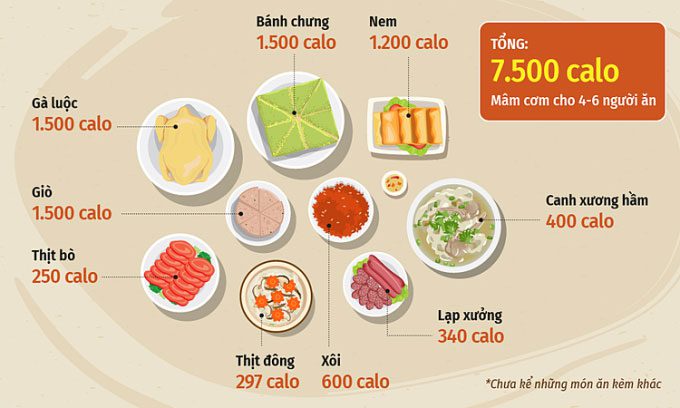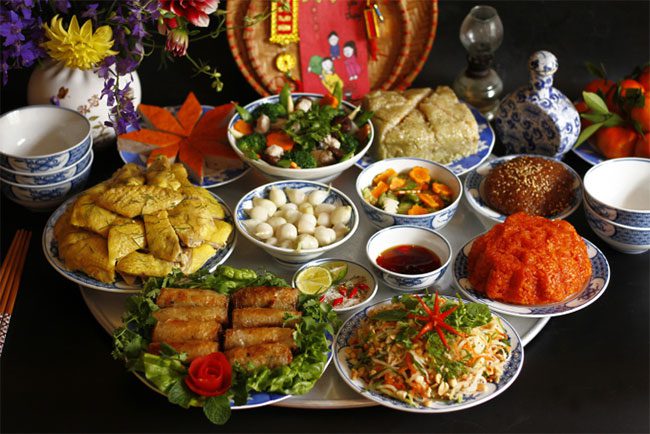As she jotted down the dishes to prepare for the five days of Tet, Ngoc, 34 years old, shook her head in dismay, even feeling haunted by the thought of a table filled with meat, starch, and fried foods.
In her sixth year as a daughter-in-law in Thường Tín, Ngoc has gradually adapted to her in-laws’ customs, yet she still feels discouraged when she thinks about spending 18 hours a day in the kitchen during the Tet holiday. She explained that her in-laws have many siblings, most of whom work far away, making Tet the only time of the year for everyone to gather.
A “traditional-style” meal at her in-laws’ house typically includes bamboo shoots with pork hocks, clear soup with balls, chicken noodle soup, mushroom meatballs, lotus seed chicken stew, boiled chicken, fried spring rolls, pork sausage, gac sticky rice, bánh chưng (square sticky rice cake), jellied meat, stir-fried chicken gizzards with vegetables, and fried shrimp… Whenever guests arrive, the three daughters-in-law rush to prepare a fresh meal, bountiful enough to resemble an offering table.
“All these high-protein dishes leave everyone feeling uncomfortable, bloated, and with indigestion, but my in-laws are adamant about keeping the family traditions,” Ngoc said.

Caloric count for a Tet feast. (Graphic: Tạ Lư).
Last year, she suggested reducing the number of high-protein dishes and replacing them with more vegetables, but her mother-in-law flatly rejected the idea, insisting that “it must be complete and fulfilling to be considered Tet.” Everyone believes that since Tet lasts only three days each year, everyone wants to “eat well and lavishly” to ensure prosperity throughout the year. Accepting her in-laws’ traditions, Ngoc prepared digestive enzymes, stomach medications, diarrhea treatments, yogurt, and various fermented drinks, ready to “detoxify” her family.
The indiscriminate eating habits during Tet are also a concern for Mai, 33 years old. Mai’s father-in-law, as the head of the family, often organizes gatherings with dozens of attendees at the end of the year. Each day during Tet, her in-laws prepare five meals, with people bustling in and out from dawn until midnight. After Tet, her two children gain weight, suffer from bloating and indigestion, while her husband suffers from stomach pain requiring monthly treatment.
“My husband is the eldest grandson, complaining of a full stomach but still holding a glass of wine for toasts non-stop,” Mai recounted, adding that each Tet occasion brings stress and insomnia due to overeating.
Associate Professor Dr. Nguyễn Duy Thịnh, a former staff member of the Institute of Biotechnology and Food Technology at Hanoi University of Science and Technology, stated that the belief that “on the eve of Tet, there must be meat hanging in the house” or “hungry for my father’s death, full for three days of Tet” is deeply ingrained in the Vietnamese consciousness. During this time, people tend to eat excessively, with dishes that are complex and rich in nutrients as a way to “wish for good fortune,” hoping for abundance in the new year. Many people indulge in festivities and drinking, leading to indiscriminate eating habits, often referred to as “dragon-style eating,” which can harm health.
Moreover, Tet is a time for people to relax more, exercise less, and have slower energy expenditure. Dishes tend to be high in sugar, fat, and protein from meat and fish, with few vegetables.
Overeating and drinking excessively, combined with lack of exercise, are key risks that lead to illness, increasing the incidence of health issues during the holiday season, the professor remarked.
Consuming too many calories can result in excess energy, leading to overweight and obesity. Many individuals experience diarrhea or constipation, and digestive disorders. High protein intake can harm the liver and kidneys. People with chronic illnesses, high blood pressure, high cholesterol, and diabetes face a higher risk of complications.

Diverse and colorful Northern Tet feast. (Photo: Bùi Thủy).
Similarly, Dr. Nguyễn Văn Tiến from the Center for Nutrition Education and Communication – Nutrition Institute, noted that during Tet, many families eat irregularly, skip meals, and consume more than usual. The consumption of meat and fish increases while vegetable intake decreases, leading to imbalanced diets.
For example, a medium-sized square bánh chưng, cut into eight pieces, weighs about 114 grams and provides 204 calories, 4.7 grams of protein, 5.6 grams of fat, and 33.9 grams of carbohydrates. Thus, one bánh chưng on the feast table can contain around 1,500 calories; one piece of bánh chưng provides energy equivalent to a bowl of white rice (about 180-200 calories).
A plate of gac sticky rice weighing 100 grams contains up to 600 calories, while a plate of peanut sticky rice weighing 100 grams provides about 400 calories. Eating one bowl of sticky rice (about 1/5 of a plate) contains around 130 calories, equivalent to 1/3 of a bowl of pho (400 calories). Additionally, 100 grams of jellied pork, roughly equivalent to a small bowl, will contain about 297 calories.
Furthermore, jellied meat has high water, protein, and fat content, providing significant energy and containing up to 21.5 grams of fat. 100 grams of spring rolls contain 137 calories, and when fried, the calorie count increases by about 120-150 calories per 100 grams. A plate of spring rolls (about 10 pieces) on the Tet meal table contains approximately 1,200 calories.
Additionally, Tet foods pose a risk of unsanitary conditions due to frequent reheating or long storage.
To ensure health, experts recommend only eating until 80% full. Science also shows that the stomach takes 20 minutes to send signals to the brain about the amount of food the body has absorbed. Instead of continuing to eat until overly full, you should put down your chopsticks when you still feel slightly hungry. After a while, your body will feel comfortable and at ease. Eating enough calories helps avoid bloating, indigestion, and sluggishness during Tet.
Additionally, people should balance the three energy-yielding nutrients: carbohydrates, proteins, and fats. Carbohydrates should make up 50-60% of the diet, preferably sourced from vegetables, as well as from whole grain bread, brown rice, and potatoes within recommended amounts.
Protein sources from both plants and animals are recommended to constitute 13-20% of total energy intake. The doctor advises to “lean more towards plant proteins, rather than completely avoiding animal proteins.” Animal proteins should primarily come from seafood, followed by chicken, duck, geese, pork, and beef.
Animal-based fats, such as lard (from meat and fish) and plant-based fats, such as oils (from nuts and fruits), should be included.
Other healthy eating practices recommended include eating at regular meal times, limiting sweets, soft drinks, and especially alcohol. Excessive alcohol consumption can negatively affect health, pose safety risks while driving, and increase the risk of cardiovascular diseases, gout, high blood pressure, and diabetes.
“Tet is a time for gathering and family reunions, so there’s no need to be overly perfectionist about food or indulge excessively, which can lead to health disasters,” warned Associate Professor Thịnh.




















































